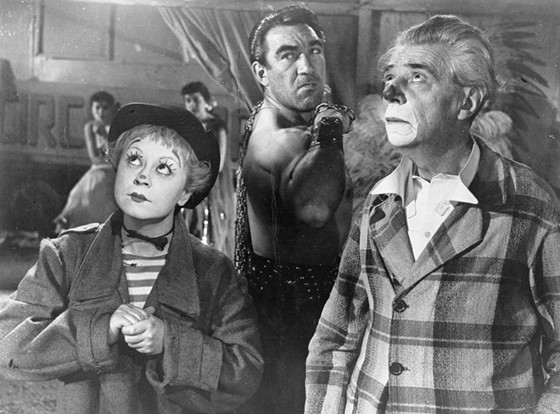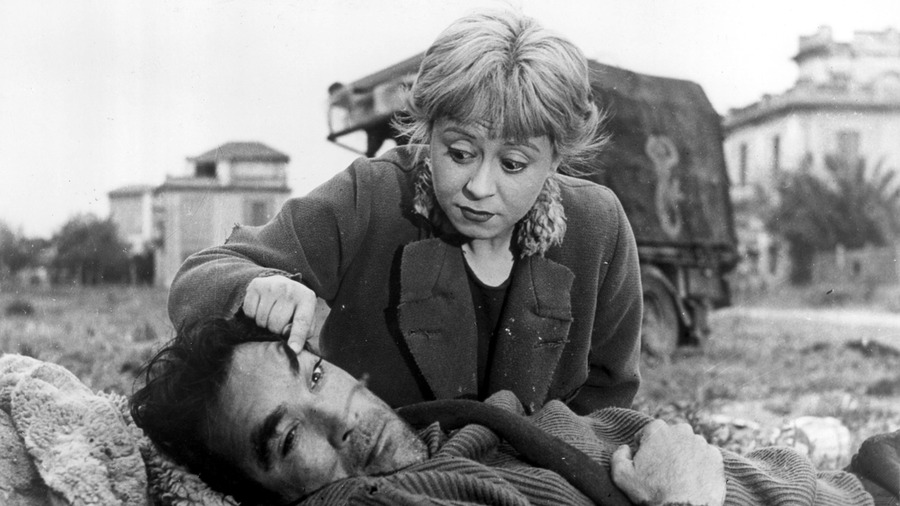
Federico Fellini was one of the most effective filmmakers in cinema history. The filmmakers and artists who are inspired by Fellini’s works are numerous. Lina Wertmuller, Martin Scorsese, Terry Gilliam, Emir Kusturica, David Lynch, and Tim Burton have all clearly admitted to be influenced by Fellini’s works. The fact that the expressions “Fellinian” and “Felliniesque” are common among cinema critics and filmgoers plainly underlines the vastness of Fellini’s impression on contemporary cinematic narration.
He created an extremely personal language that, if one doesn’t know the title or doesn’t have any previous acknowledgement of the identity and the film’s background, they most likely can guess the filmmaker’s name. His narrative and technical style is his very professional signature.
He playfully mixes up dream scenes and reality, and for this very reason one of the traits listed below is the passage from Neorealism. Most interestingly, Fellini uses every cinematic material, costume, color, music, and storyline in the most playful mode possible. Later, he dared to use his courageous and innovative approach in editing, as in “8 ½” (1963).
Fellini was nominated for 12 Academy Awards; four of his films won the Oscar for Best Foreign Language Film: “La Strada” (1954), “Le Notti di Cabiria” (1957), “8 ½” (Otto e Mezzo, 1963) and “Amarcord” (1974). He won the Palme d’Or for “La Dolce Vita” (1960) and in 1993, he was granted an honorary Lifetime Achievement Oscar.
As always, if you think you can add to this list, do not hesitate to recommend additions.
1. Referring to life as a circus

This playful approach towards daily rituals and routines has turned to a recognizable specification of Italian cinema. Though Antonioni’s “Blow Up” (1967) takes place in London, the circus as a decisive element marks the film as an Italian narration, an element which is visually opposed to London’s more serious look.
In fact, referring to life as a circus is notable in more than one film from Antonioni; the most clear example is the dancing scene in “La Notte” (1961) where the characters refuse to exchange dramatic information, and the woman (Jeanne Moreau) vaguely refers to a thought she has, declaring that she wouldn’t share that very thought with the man (Marcello Mastroianni).
The aforementioned scene is long enough, though, plainly indicating the fact that if the audience wishes to be entertained, then they can just go to a circus, for life is not entertaining. It’s boring, repetitive, and crude.
This playful spirit repeats itself in some most recent productions of Italian cinema like “La Grande Bellezza” (Paolo Sorrentino, 2013); nonetheless, the use of noisy parties, feasts, and the exaggerated circus-like attitude of the characters in Sorrentino’s film is represented with a more critical approach. Sorrentino is criticizing “the big circus”, whereas Fellini is admiring it.
A similar approach to that of Fellini can be Matteo Garrone’s narrative ambient in “Il Racconto dei Racconti” (“Tale of Tales”, 2015). Garrone’s Fellinian touch to awaken reality through a surreal approach is notable in this film.
Using the circus as one of the main narrative elements allows Fellini as a filmmaker to picture his main characters as homeless, as circus characters actually are. The circus performance is something absolutely unrealistic and dreamy for the normal viewer, but the circus members are actually living that unreal life. Their houses are movable because the circus normally doesn’t stay long in one place.
Therefore, a story with the circus as one of the main narrative elements has the possibility to move and consequently represent a road movie. Since the road movie passes through the ambient and doesn’t stay in it, the film inevitably has an episodic approach.
2. “Il visionario / l’unico realista” (the only realist is the visionary) / overstepping Neorealism

Fellini, unlike Antonioni in “Blow Up”, doesn’t use the circus as a lateral concept, as he clearly doesn’t prefer a crude approach toward the reality but still uses it as material; he pokes the same concepts while dancing and laughing.
The role of music in his films is the very same role that the music has in a circus performance: covering up the ambient sound and the real sound effects of the act.
By covering the real sound, he is actually separating the sense of reality of the presented act. Likewise, the makeup of the characters and the general narrative characterization actually cover up the real appearance and the crude reality hiding underneath the joyful presentation.
In “La Strada” (1954), the miserable and extremely sad look of Gelsomina (Giulietta Masina) later gets buried under the funny face of a little clown.
Almost the same thing applies to Cabiria (still played by Masina); the sad lonely aspect of prostitute is being covered up by her overdone makeup. After all, that’s all a circus is about – making real life look entertaining and quite different than what it really is.
In “La Strada”, the general approach is quite crude and pitiless. Gelsomina has been separated from her mother and family; she has been sold to a travelling circus man, a strongman named Zampano (played by Anthony Quinn) who has returned to replace Gelsomina with her sister, Rosa, who has died since going on the road with Zampano.
Everything about Gelsomina’s life is extremely depressing, and therefore it all seems a realistic approach until one very specific scene where Gelsomina arrives to a city square after leaving Zampano. It’s night and a huge shadow, which is in fact the magnified shadow of a tightrope walker, reflected on the old city buildings.
This is a real circus and Gelsomina remains there looking up open-mouthed at the tightrope walker, who in the middle of his long walk, stops, places a table and a chair on the rope, and starts eating spaghetti. Fellini is giving an extremely important lesson here: every surreal element is based on reality. One can not find place and effectiveness without the other.
“Le Notti di Cabiria” is maybe one of Fellini’s most realistic works, and in fact, one can easily note Pier Paolo Pasolini’s touch in the screenplay. It is still a Fellinian film, since the very subject of the story and Giulietta Masina’s mode of acting still has a grotesque treatment but the brutal street life is Pasolini’s absolute territory.
3. Dream scenes

The dream scene is an essential narrative part of most of Fellini’s works. “8 ½” starts with an effective dream scene and the whole remaining time of the narration seems to be a flashback (a dream).
The dream scenes have an important dramatic potentiality since they are constructed by pieces of reality representing something that does not respect the real, physical laws of daily life. So what the character is actually seeing in their dream is a combination of real facts, already occurred incidents that have left their effect on the mind of the character.
“La Dolce Vita” and “8 ½” benefit enormously from dream scenes. while “Le Notti di Cabiria” and “La Strada” tend to be more realistic. As mentioned before, the dreamy scene of the tightrope walker in “La Strada” is actually happening; there is no flashback in such occasion, though it seems to be one.
4. Music as a part of character treatment

What later makes Zampano note Gelsomina’s absence is the vague melody that she has hummed clumsily during the whole story. She is not there anymore, but Zampano distantly overhears a child murmuring the same tune and that makes him think Gelsomina was there.
The sound undoubtedly recalls presence. When a character (in this case, Gelsomina) is represented partly by a melody, then in her absence, that very melody recalls her presence. The same approach has been repeated poorly years after in “Snatch” (Guy Ritchie, 2000), where every character (or rather, every nationality) is accompanied by a diverse musical tune.
One of the very first usages of a leitmotif for characterization has been already seen in “M” (Fritz Lang, 1931), where the murderer whistles the tune “In the Hall of the Mountain King” from Edvard Grieg’s Peer Gynt Suite No. 1. Quite similarly to Fellini’s approach, every other time we hear that tune, we know that the murderer is there, even if he’s offscreen.
The extradiegetic music of Nino Rota in Fellini’s films is of the same category of the circus music. It is apparently playful, underlining one very repetitive leitmotif. The instruments, in the case of “La Strada”, are mostly aerophones recalling the musical marches (just like the circus, the musical marches are constantly on the move). It is the same genre of soundtrack that was later used notably in Emir Kusturica’s films.
5. Sarcasm/controversial narrative situations

The same thing is respected in a circus performance: any kind of visual/narrative situation that reveals a comparison is considered a sarcastic approach. Just think about the performative couples in a circus: a very tall man is most probably accompanied by a dwarf.
The same rule can be applied in any other expressive visual combination, as any adjective is the fruit of a comparison. A fat man is considered fat if he is accompanied by a skinny man. And Fellini’s controversial situations are mirroring back this very fact: Gelsomina is an extremely little, delicate girl and, in a Fellinian way, is accompanied by the tough figure of Zampano. Who else but Fellini could have thought of Anthony Quinn and Giulietta Masina as acting partners?
Saraghina, an isolated prostitute with her exaggerated badly-done makeup, dances barefoot on the beach for school kids. The combination of the schoolboy, who can be interpreted as the symbol of innocence, with a beefy, almost scary prostitute, creates a delicate, hidden concept: maybe these figures, the schoolboy and the prostitute, are not antithetical. Maybe placing Saraghina together with school kids is an indication of her innocence and desperation.
Fellini’s films are stuffed with such narrative situations. Guido (Mastroianni) in “8 ½” dreams of a kind of harem filled with all the women of his life. They are magically obedient and all are in love with him. He is ruling all these half-naked women with a whip in his hand; an utterly altered image of his relationships with these women in real life.